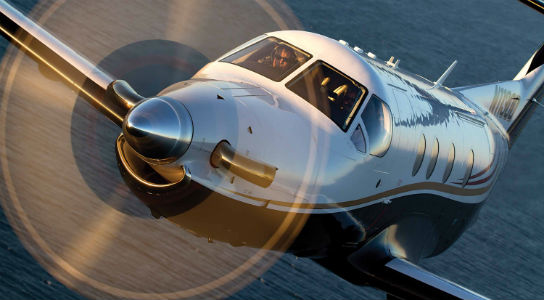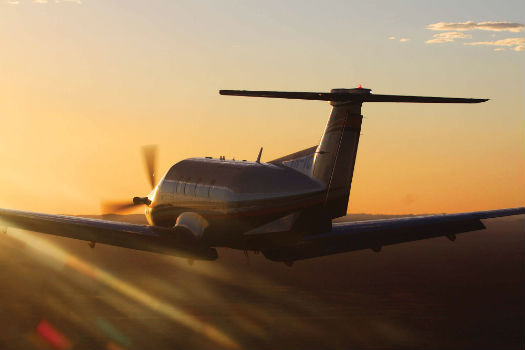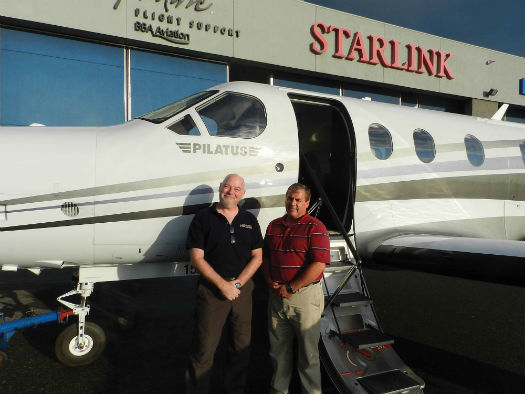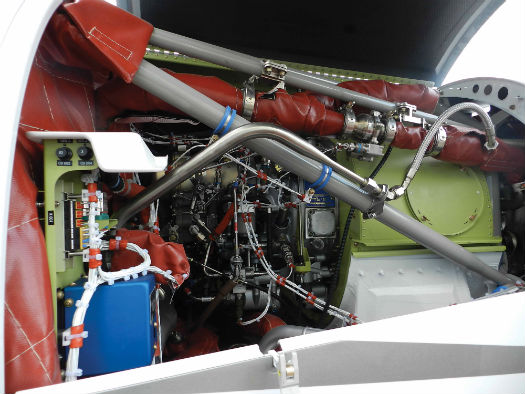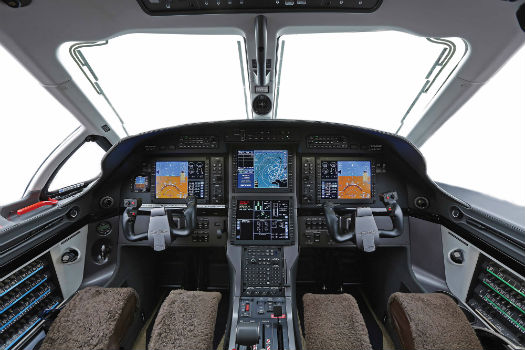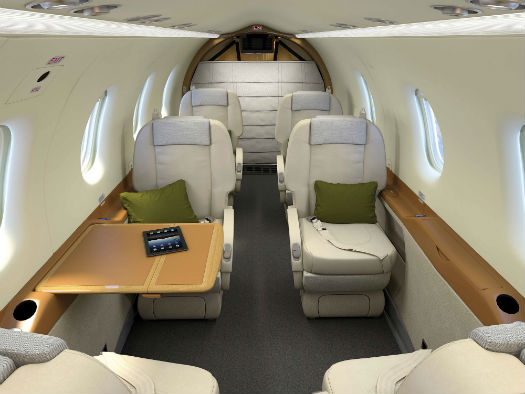Since initial certification in 1994, the PC-12 has been subject to several upgrades which mainly involved incrementally increased engine power and maximum takeoff weight.
Pilatus was right. Powering a big, high-performance turbine aircraft with just a single engine is a fine idea, but it did raise a few eyebrows when the PC-12 concept was introduced in 1989. Cessna’s single-engine turbine Caravan had pioneered the concept, but nobody was sure whether the market would accept carrying passengers in the Flight Levels behind one engine—even one as reliable as the legendary PT6. Whatever the objections, the operating economy and flexibility of the big Swiss single soon won people over in droves. To date, the PC-12 fleet of over 1,500 aircraft has amassed in excess of five million flight hours. You know what they say about building a better mouse trap. The world beat a path to Pilatus’ door.
Since initial certification in 1994, the PC-12 has been subject to several upgrades which mainly involved incrementally increased engine power and maximum takeoff weight. The latest variant is the PC-12/47E, commonly called the PC-12 NG, for “Next Generation.” Introduced in 2008, it was a big upgrade, integrating the Honeywell Primus Apex avionics suite and finally giving the PC-12 a fully integrated glass cockpit.
Although skeptical when the design was first introduced, operators have now wholeheartedly adopted Pilatus’ PC-12 NG. To date, the PC-12 fleet of over 1,500 aircraft has amassed more than five million flight hours. Pilatus Photo
Levaero Aviation (formerly Pilatus Centre Canada) offered a PC-12 NG, serial number 1528, for a test flight from Montreal’s Trudeau Airport in June 2015. Our demonstrator aircraft had the Premium avionics suite, including the Enhanced Vision System (EVS) which provides the pilot with see-in-the-dark “Superman vision” overlaid upon the multifunction display from an infrared sensor on the nose. It was also fitted with the optional five-bladed MT propeller, which offers reduced noise and some improved performance. It is difficult to define a “standard” configuration for the PC-12 NG, as the optional equipment catalogue is extensive, particularly in regard to avionics and interior options.
POWERFUL FIRST IMPRESSIONS
The PC-12 NG is a big single, standing 14 feet tall, with a 53-foot wing span. Levaero demonstration pilot Scott Running offered a show-and-tell pre-flight inspection, where utility was evident in the design. The counterweighted cabin door allows the pilot to close it en route to the cockpit after the passengers are settled—just like a jet. Passengers will appreciate the in-flight accessible aft baggage compartment. A huge 52×53-inch aft cargo door makes loading a snap.
Skies test pilot, Rob Erdos, is all smiles after flying the Pilatus PC-12 NG with Levaero demonstration pilot, Scott Running.
The term “Swiss precision” is a marketing cliché, but it seemed appropriate as I noted the workmanship evident in every component. Every part fit seamlessly. The interiors of inspection panels were painted, labelled, and clearly designed for easy access. I got the impression that maintaining the PC-12 NG would be a breeze. Under the cowling lurked the Pratt and Whitney Canada PT6A-67P engine. Capable of 1,845 horsepower, it was de-rated to 1,200 horsepower for takeoff and climb and 1,000 continuous horsepower for cruise. Dual gear-driven 300 amp generators provide redundant power to the dual bus electrical system.
The wings incorporate dual spars, each with integral 200 US gallon fuel tanks which feature over-wing fuelling. The NG can be visually identified by its distinctive winglets, which are a swoopy low-profile rounded design; the third iteration of winglets designed for the PC-12. The solid trailing link undercarriage has a 14-inch stroke, which allows the PC-12 NG to operate from grass, gravel and dirt strips.
GETTING STARTED
Climbing the air stair, I cast a worried glance at the sky. Our round-robin flight plan was to take us west toward Ottawa before returning to Montreal for an instrument approach; however, the dark towering cumulus and showers that loomed in that direction made me skeptical that our cunning plan would succeed.
The generous slotted Fowler flaps contribute to the PC-12 NG’s impressive field performance. Rob Erdos Photo
Settling into the cockpit, my first impression was that I wouldn’t change a thing. The field of view was generous, and the equipment layout seemed functional and conventional. The audio panels were on the upper instrument panel in front of each pilot. The autopilot mode selector panel was top-dead-centre. One 10.4-inch primary flight display was in front of each pilot, with two more multifunction displays stacked in the centre panel.
The PC-12 NG is pleasantly simple to operate. The Before Starting Engine check consisted mainly of programming the avionics and performing a few press-to-test checks. Upon power up, the avionics were awake and functional within a minute, following which I was pleased to see that the Primus Apex system allowed us to enter a flight plan on battery power before engine start. The tabbed interface is a bit PC-like, and I found myself adapting to it quickly. I liked the way that Honeywell segmented the primary flight display into windows that depicted critical flight and navigation data, engine data and radio selections, putting the most frequently used information front and centre. The two stacked multifunction displays could depict a moving map and display the programmed flight plan with enough room left over for a full-sized approach plate.
The cowling provides ready access to the 1200 HP P&WC PT6A-67P engine. Rob Erdos Photo
Interface to the avionics is via an alpha-numeric keypad supplemented with hot keys on the display bezels. Shortcut buttons provided a direct vector into the most frequently used functions. A joystick on the keypad allowed control of the cursor. As with most modern avionics, there seemed to be multiple ways of accomplishing most tasks. If reaching for the instrument panel seems like too much effort, a cursor control device (a.k.a. trackball) on the aft end of the centre console allowed direct access to most features. I take it as indicative of good design that my unfamiliar fumbling guesses were successful in most cases. I imagine that I would have done better with some training.
The theme of simplicity continued with engine starting: press the STARTER button, watch the Ng pass 13 per cent, check for oil pressure and then move the condition lever to GROUND IDLE. The starter cut out automatically and the idle stabilized at 65 per cent Ng. Additional housekeeping before taxiing included setting 15 degrees flap (30 degrees is optional for short strips), and testing the stick shaker/pusher and ice protection systems.
The Honeywell Primus Apex avionics system provides impressive capability in the PC-12 NG. Pilatus Photo
Ground handling was effortless. Taxi speed at Ground Idle was easily regulated with occasional gentle applications of reverse thrust in lieu of braking.
A PLEASANT INTERLUDE OF AIMLESS VECTORING
Taking position on Runway 24L, I was greeted by the sight of large convective clouds to the west of Montreal. Rain had begun falling. I glanced at Running. He nodded. I rolled. I had been briefed to rotate at 81 knots, but when ready to fly the PC-12 NG doesn’t so much rotate as levitate in a fairly flat attitude. The engine torque limiter is set at 44.34 psi, but Running suggested I set power at 41 psi to allow for ram rise during takeoff. The post-takeoff check involved retracting the undercarriage and flaps and engaging the yaw damper. Again, simple.
Is this really the interior of a propeller-driven single? Pilatus Photo
Immediately after takeoff, we received the first of a series of vectors from air traffic control, as they attempted to steer us clear of the conga line of inbound traffic attempting to maneuver around the growing storms. Getting a block of airspace for air work was out of the question, but I “pretty please” requested a climb to FL260 (26,000 feet). Running recommended a climb power setting of 36.9 psi torque at cruise-climb speed of 140 knots indicated airspeed (KIAS). At higher altitudes, climb power is limited by inter-turbine temperature (ITT). Maximum climb ITT is 820 degrees Celsius, but 780C is recommended to prolong engine life. At the best rate of climb speed of 120 KIAS, the Flight Manual quotes a respectable 1,920 foot-per-minute rate of climb at sea level, maximum gross weight.
Cruise power settings are derived from a chart. At FL260 and -26C (ISA+10C), we set the maximum cruise power setting of 27.2 psi engine torque. In exchange for 382 pounds per hour fuel flow, the PC-12 NG zipped along at 262 knots true airspeed (that’s 0.424 Mach, for jet snobs). Our performance matched the Flight Manual almost exactly. My notes read, “Quiet!”, and “Smooth!” even sitting behind the big spinning propeller. A single propeller, that is, but this was certainly not the sort of performance that I associated with the words “single-engine propeller airplane.”
TAKING ITS MEASURE
Then I turned around and was astonished to see what was behind me: an enormous cabin was following us through the sky! The cabin is 58 inches high by 60 inches wide and almost 17 feet long. To help you visualize, the cabin is just long enough to park two Smart cars, and they’d actually fit inside—provided you let the air out of the tires. That’s a big single! I suspect that Pilatus wouldn’t endorse my parking idea, but approved interior configurations include a nine-seat commuter cabin, a plush six-seat executive interior, a four-seat “combi” cargo layout, and an aeromedical interior.
Our demonstrator aircraft had a Basic Operating Weight of 6,847 pounds; somewhat higher than the published 6,173 pound typical empty weight, but our demonstrator aircraft was very well equipped. With 1,562 pounds of fuel, two average-sized human pilots, and 100 pounds of cargo, our gross takeoff weight was 8,868 pounds, well below the 10,450 pound maximum takeoff weight.
The five-blade propeller serves to remind the pilot that he’s not flying a jet. Rob Erdos Photo
Consider the options. Had we decided to maximize payload, the 9,039 pound maximum zero fuel weight would have allowed 2,192 pounds of payload, while still leaving room for over three hours of fuel! If range were our objective, full fuel totalling 2,703 pounds would have left a payload of 900 pounds, which amounts to four people and a bit of luggage. Fully fuelled, Pilatus quotes a maximum range in excess of 1,800 nautical miles.
Air traffic control had been patient with us, but we got a strong hint that they wanted us out of their hair. We received a slam dunk clearance for a steep descent to a short visual final approach. The ability to extend the undercarriage at up to 180 KIAS helped us fit in with the busy jet traffic. Our landing reference speed was 101 KIAS, and the PC-12 NG felt solid and predictable in my unfamiliar hands as we settled onto Montreal’s Runway 06 Left. The Flight Manual says that we could have stopped in 1,830 feet at maximum landing weight.
Adaptability to diverse missions is the strength of Pilatus’ PC-12 NG. Pilatus Photo
I generally avoid making direct comparisons between an airplane and its competition, but in the case of the PC-12 NG, it’s easy: there isn’t any! There are other aircraft that can compete on specific missions; but in regard to overall utility, the PC-12 NG is in a class of its own. With a huge cabin, generous payload, long range, certification for flight into known icing, single-pilot operation, and approval for operations from grass, gravel or dirt strips, there are few missions that the PC-12 NG cannot tackle.
I wouldn’t be the first person to make a comparison to a Swiss Army knife, but the analogy is apt. Pilatus’ big single seems be adaptable to myriad uses. The PC-12 NG is the farthest thing from a single-point design, having found favour in missions ranging from charter, private transport, corporate shuttle, aeromedical, law enforcement, cargo and military special operations. The chameleon-like flexibility of the cabin configuration, combined with its impressive efficiency, explains the PC-12 NG’s phenomenal success.
Robert Erdos is a contributing editor for Skies magazine. He is a professional test pilot with over 8,000 hours of flying experience on a wide variety of aircraft. A graduate of the U.S. Navy Test Pilot School, he is a former RCAF test pilot who now works as an Experimental Test Pilot for the National Research Council in Ottawa. In his spare time, he does formation and airshow aerobatic flying as a pilot for Vintage Wings of Canada.
